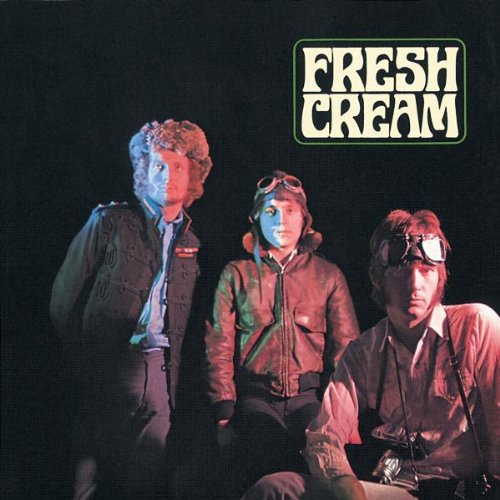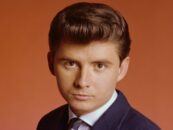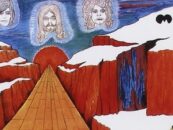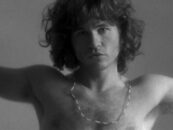 “When everyone is clicking, there’s nothing more powerful than a three-piece band.” That’s the assessment of Joe Walsh, who made the observation during a recent chat with this author about a certain beloved trio he played with in the early ’70s. Indeed, over the years, the notion of a three-piece band has found its way into several rock genres—from prog to punk to that most famous of three-man formats: the power trio. Remarkably, however, the number of three-piece ensembles that have found mainstream success is less than one might expect, at first blush. Below, we profile 10 classic rock trios that did achieve a perennial spot in music history.
“When everyone is clicking, there’s nothing more powerful than a three-piece band.” That’s the assessment of Joe Walsh, who made the observation during a recent chat with this author about a certain beloved trio he played with in the early ’70s. Indeed, over the years, the notion of a three-piece band has found its way into several rock genres—from prog to punk to that most famous of three-man formats: the power trio. Remarkably, however, the number of three-piece ensembles that have found mainstream success is less than one might expect, at first blush. Below, we profile 10 classic rock trios that did achieve a perennial spot in music history.
ZZ Top
ZZ Top’s run of nearly five decades with the same lineup is classic rock’s equivalent of Joe DiMaggio’s 56-game hitting streak—both are records unlikely to ever be broken. During that stretch, band members Billy Gibbons, Dusty Hill and Frank Beard crafted a remarkably consistent catalog of incendiary blues-rock combined with driving Texas boogie. Additionally, the trio doesn’t get enough credit for the synthesized blues-rock sound it pioneered in the ’80s, with songs such as “Legs” and “Sharp Dressed Man.” Few bands have found more ways to extract new permutations from a fundamental style.
James Gang
For a time, it looked as though the James Gang was destined to carry the power-trio torch first fired up by Cream and the Jimi Hendrix Experience. Yer’ Album, the band’s 1969 debut, saw drummer Jim Fox, bassist Tom Kriss and guitarist-singer Joe Walsh establish a riff-driven sound that earned praise from the likes of Pete Townshend. With Dale Peters replacing Kriss, the trio went on to record two more classic LPs, Rides Again, and Thirds, before Walsh exited to launch his solo career. Thanks largely to Walsh’s distinctive style, tracks like “Funk #49” and “Walk Away” rank among classic rock’s most instantly recognizable songs. James Gang forged on for several years without Walsh, but nothing they produced afterwards matched the “thrill of the new” evident on those first three records.
Related: The rise of Joe Walsh
Blue Cheer
Blue Cheer underwent countless restructurings in personnel, but their late ’60s groundbreaking work was generally forged as a trio. Emerging from San Francisco’s psychedelic scene, founding members Dickie Peterson, Paul Whaley and Leigh Stephens helped create a template for the thunderous, primal sound later christened “heavy metal.” Indeed, more than one rock historian has cited the band’s volcanic 1968 cover of Eddie Cochran’s “Summertime Blues” as heavy metal’s ground zero. No less an expert than the Doors’ Jim Morrison once described Blue Cheer as “the single most powerful band I’ve ever seen.”
Rush
No other band has merged hard rock and prog as effectively as Rush has. Especially on their breakthrough 1976 album, 2112, the Canadian trio fused Geddy Lee’s banshee wail, Neil Peart’s propulsive drum work and Alex Lifeson’s guitar versatility into a distinctive style that’s served them well for decades. The band’s progressive talents are on full display on 2112’s epic title track, while shorter pieces such as “Tom Sawyer” and “Limelight” (both from the 1981 LP Moving Pictures) have become staples of classic rock radio. Critical assessments of Rush’s catalog have been on an upward trajectory in recent years. [Rush’s recordings are available here.]
Related: The documentary for another Canadian power trio, Rush, has been released
Grand Funk Railroad
Few groups were more deserving of the “People’s Band” designation than Grand Funk Railroad in their heyday. Dismissed by many critics, the Michigan-based trio—Mark Farner, Don Brewer and Mel Schacher—took their music straight to their fans, touring incessantly and releasing platinum-selling albums chock full of working-class slogans and blues-rock swagger. Even today, tracks like “Mean Mistreater” and “I’m Your Captain” evoke the communal spirit central to the band’s appeal. Rechristening themselves “Grand Funk,” the band later added a keyboardist and earned critical favor with their We’re an American Band album, but for many fans, those early years remain particularly special.
The Police
Of all the major bands to emerge during the late ’70s punk and new wave movement, the Police may well have been the most unique. While initially pegged to those genres, the gifted trio’s musical ambitions quickly took them in directions far outside those narrow parameters. Buoyed by Andy Summers’ intricate guitar arrangements and Stewart Copeland’s polyrhythmic percussion, bassist-singer Sting proved to be one of the era’s most polished, charismatic frontmen. Together, as demonstrated on songs such as “King of Pain” and “Don’t Stand So Close to Me,” the trio appeared ready-made for pop perfection—and for a time, they were. [Their Synchronicity album received a 40th anniversary edition in 2024.]
Motörhead
For nearly four decades Motörhead occupied a sweet spot where punk and metal collided. While the band’s lineup sometimes expanded beyond the trio format, both the early years and the later years saw frontman Lemmy Kilmister and his mates put forth their raging style as a threesome. Songs such as the thunderous “Bomber” and the classic “Ace of Spades” helped define thrash-metal and influenced scores of young bands that were drawn to similar sound and fury. Small wonder that Lemmy’s death earlier this year was mourned by fans—and fellow rockers—far and wide.
Emerson, Lake & Palmer
No band embodied the grand-scale ambitions of the prog-rock movement more fully than Emerson, Lake & Palmer did. Weaving classical music flourishes into a contemporary rock fabric didn’t always yield seamless results, but at their best, band members Keith Emerson, Greg Lake and Carl Palmer gave rock ’n’ roll an element of high-brow credibility. The trio’s 1972 hit, “From the Beginning,” remains requisite learning for rock guitarists aspiring toward a classical approach, while “Karn Evil 9” did for rock keyboards what Jimi Hendrix did for electric guitar. [Their recordings are available here.]
Cream
Along with the Jimi Hendrix Experience, Cream established the template for nearly every power trio that came in their wake. Featuring a thunderous rhythm section in the persons of Jack Bruce and Ginger Baker, and a young guitar goliath in Eric Clapton, the band unleashed a new, adventurous sound that helped pave the way for the likes of Led Zeppelin, Black Sabbath and the Jeff Beck Group. Tracks such as “White Room” and “Sunshine of Your Love” mixed blues, hard rock and psychedelia in ways previously unimagined.
Jimi Hendrix Experience
Simply put, the Jimi Hendrix Experience expanded the possibilities for electric-guitar-based rock beyond anyone’s wildest dreams. Tethered to drummer Mitch Mitchell’s jazz-flavored grooves and bassist Noel Redding’s anchoring bass lines, Hendrix obliterated the line between lead and rhythm guitar, crafting six-string arrangements that were near-orchestral. Tracks such as “Purple Haze,” “Hey Joe” and “The Wind Cries Mary” framed traditional blues in otherworldly textures. At the time of his death, Hendrix was looking to expand his music and his band format, but the image of him onstage, flanked by just two sidemen, remains indelible.
Related: Hendrix’s other great trio, Band of Gypsys
- Singing Rock Drummers: From the Skins to the Mike - 03/02/2025
- Rod Stewart & Friends: 10 Great Collaborations - 01/10/2025
- Band on the Run: The LP That ‘Saved’ McCartney - 12/05/2024






27 Comments so far
Jump into a conversationYou forgot one great 3 piece band, from Canada-Triumph.
That was my immediate first thought. No way they aren’t at least honorable mention
Russell, Thanks for acknowledging Blue Cheer! Very few I reminisce with about excellent power Rock with remember them..I’lll NEVER forget their version of Parchment Farm!!! Thanks
I loved Blue Cheer! One of the beat things about them was sitting around trying to figure out who the hell was actually in the band. Haha.
I thought Mountain might have got into the 10 ….
They were really known more as a quartet than a trio. Great band though!
I share your sentiments about Mountain, but I also think that Robin Trower belongs somewhere on this list. BTW, Pat Travers released 2-great Power Trio (P.T. Power Trio) featuring great covers. Michael Schenker & Davy Pattinson also released 2 power trio (plus Pattinson on vocals) of covers that are also very good.
You guys forgot the ‘greatest rock trio’ ever……….TRAPEZE!!!!!
Trapeze were my favorite for sure.
are you kidding? Greatest? tried watching a few videos, and listening to their tunes. They’re okay, but they are no “Greatest”.
If they’re out there playing clubs to re-live their legacy, then you are not great.
Rory Gallagher’s TASTE.
I think “Taste” featuring Rory Gallagher should definitely be in your top 10
“HOT F***ING TUNA” America’s Choice 1975, Yellow Fever 1975, Hoppkorv 1976, “Academy of Music / Palladium” NYC, Jorma, Jack Casady & Bob Steeler set sometimes lasted 4 to 5 hours. No trio was more intense.
I was there late show began 11:30 PM and didn’t end until 5:30 AM. Lost my hearing for two days but had a smile on my face for two weeks. I could still feel the thumping of Jack Casady’s bass after all these years.
HOT TUNA THE BEST THEY DEFINITELY SHOULD BE IN THIS TOP 10 I’VE BEEN TO MANY MANY TUNA CONCERTS ESPECIALLY THE ACADEMY OF MUSIC ONES START AT MIDNIGHT FINISH AT 6 OR 7 AM NOTHING LIKE A 20 TO 25 MINUTE WALKIN BLUES WITH SOLOS. THEY HAVE LONGEVITY STILL TOURING DEFINITELY IN MY TOP 10. LISTENING TO BURGERS AD I WRITE THIS.
Have been an Emerson, Lake, & Palmer fan since my first ever concert at 14 yrs. old in 1974. There was a phenomenal amount of talent spread between three people. I was always amazed at how they could make themselves sound like there was 10-15 musicians on stage. Unfortunately, a trio means you’re stuck with the same two other people all the time. In their case, they were great friends who one they got in the studio, found out they had very different musical opinions. I’m actually surprised they lasted as long as they did considering the deep divide hey had musically, and the amount of time they spent together at the beginning of the group. The first five years they did nothing but tour and record non-stop.
Triumph
Come on! No Johnny Winter? Also SRV & Double Trouble!
Where is Triumph!
It’s nice to see Grand Funk Railroad get some love for a change, The fans loved this band, and the critiques hated them.
They also get props for telling the critiques , right where to stick it, even thought it may have cost them a chance to get into the “Rock and Roll hall of fame, Where they belong,
You don’t sell 25 million albums, and sell out every concert you play. and get the love they got from the fans and not be considered for the Rock Hall.
How about West, Bruce, and Laing?
Or…Baker, Bruce, and Moore?
OK. But add Beck, Bogart + Appice, West, Bruce + Laing, Mountain, and Barnstorm.
I’d loved to see an article on power trio + one [a singer], such as The Who & Led Zeppelin.
Seriously missed on not including Robin Trower.
Rose Hill Drive deserve to be included here.
how is it that Robin Trower isn’t even mentioned, I don’t understand.
Hard to argue with the list above, but sure would have been great to see King’s X get some love…ah well, maybe when the list gets reprinted and expanded to Top 11